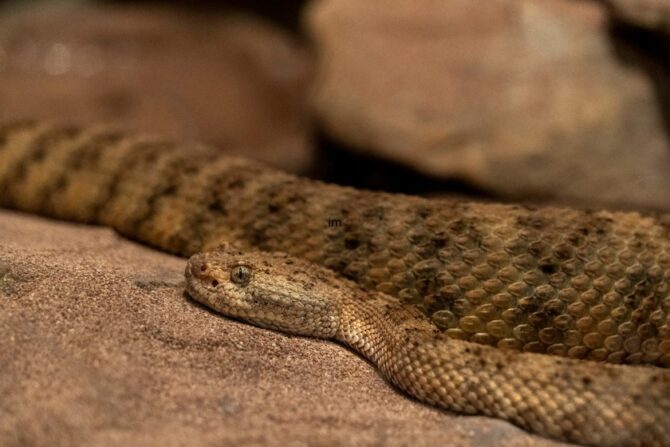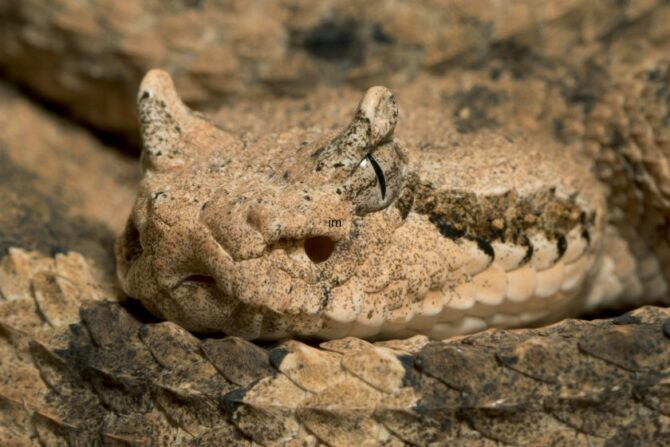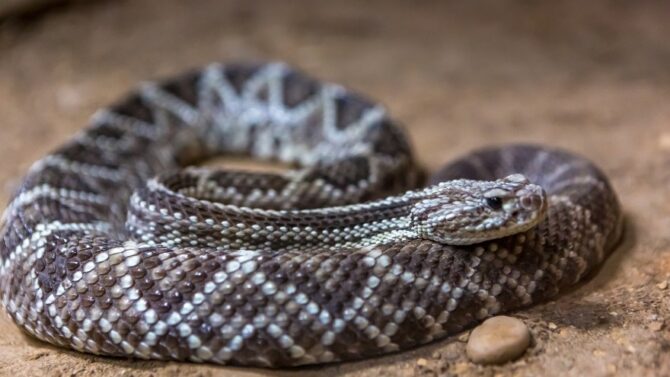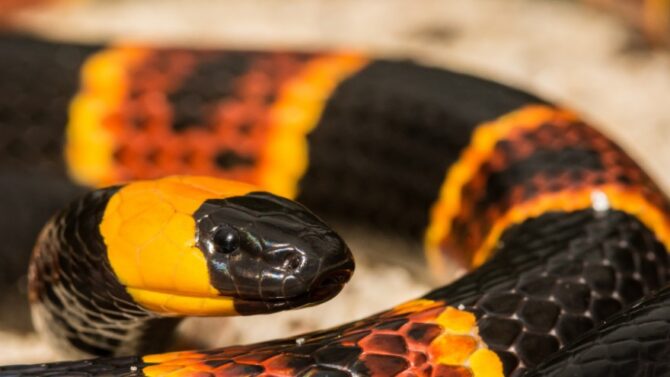California is the third-largest state in the United States, located on the Western coast of North America.
This state is home to many snakes, including venomous and non-venomous ones.
There are seven venomous snakes in California, all of which are rattlesnakes. These snakes are mostly found in different areas of the state below sea level to the height above.
Read on to learn more about the different species of rattlesnakes in California and their habitats, traits, and threats to humans.
7 Venomous Snakes in California
1. Western Rattlesnake

- Scientific Name: Crotalus oreganus
- Size: 48 to 72 inches
- Habitat: Riverbanks, parks, golf courses, river valleys, foothills, grassland, and residential areas
- Identifying Features: Triangular head, dark stripes, a white border from eyes to the jaw, excellent camouflage
- Behavior: Nocturnal during hot summer, passive, non-aggressive, camouflages
- Threats to Humans: Burning pain at the site of the bite, skin discoloration and blistering, blurred vision, bleeding, swelling, nausea and vomiting, and twitching of the eye and mouth
The western rattlesnake, also known as the Northern Pacific rattlesnake, is the most common rattlesnake in California.
Its size varies but falls at an average of 72 inches.
Western rattlesnakes have mixed colors, mostly dark brown, yellow, dark gray, greenish-gray, and olive-brown.
These colors help them camouflage excellently in their surroundings.
They also have triangular-shaped heads, dark stripes, and white borders that run from their eyes to the angle of their jaw.
Western rattlesnakes are mostly found in riverbanks, parks, golf courses, foothills, and residential areas.
They are always active except during the hot summer months when they become nocturnal.
Western rattlesnakes typically lay ambush for their prey and feed mostly on small mammals, birds, lizards, frogs, eggs, and insects.
They are generally known to be passive and non-aggressive, but their venom is highly toxic.
The effects of their venom on the victim depend on the victim’s age and health status.
Typical symptoms include burning pain at the site of the bite, puncture marks, skin blistering and darkening, swelling, bleeding, twitching of eyes and mouth, numbness, breathing difficulties, blurred vision, nausea, and paralysis.
If the bite of a western rattlesnake is left untreated, the victim may die.
2. Red Diamond Rattlesnake

- Scientific Name: Crotalus ruber
- Size: 30 to 65 inches
- Habitat: Mountains, coastal areas, dense chaparral region, desert, and rocky grasslands
- Identifying Features: Thick body, large triangular-shaped heads, red color with diamond-shaped blotches, and black-and-white stripes at the end of its tail
- Behavior: Solitary, nocturnal, sometimes diurnal
- Threats to Humans: Large venom yield
The red diamond rattlesnake is also called the northern red rattlesnake.
This snake has a thick body, an angular head, and a rattle at the end of its tail.
Red diamond rattlesnakes have various sizes but average between 30 and 60 inches.
They can be identified with their unique red color, diamond-shaped blotches down their back, and an alternative black-and-white band at their tails.
They are mostly found around coastal areas like streams, mountains, deserts, dense shrubs, and wild vegetation areas.
Red diamond rattlesnakes are venomous like every other pit viper.
While their venom is less toxic than that of other rattlers, a single bite from an adult red diamond rattlesnake can deliver a large amount of venom—three times the dose that could kill a human.1
When cornered, these snakes use some defensive displays, like coiling, rattling, and striking, as a self-defense mechanism.
Their bites can lead to blood clotting defects, internal bleeding, tissue and muscle damage, infections, and death.
3. Western Diamondback Rattlesnake

- Scientific Name: Crotalus atrox
- Size: 48 to 60 inches
- Habitat: Desert, grassy plains, forested areas, rocky hillsides, and riversides
- Identifying Features: Broad spade-shaped heads, two diagonal lines on each side of its face, brick red, pinkish-brown, milk white color, diamond-shaped blotches on its back, and white scales linings
- Behavior: Aggressive, nocturnal, and ambushes prey
- Threats to Humans: Large venom yield
Western diamondback rattlesnakes are among the venomous rattlesnake species in California.
They have a large spade-shaped head and a black “mask” stretching over their eyes.
They also have various color patterns like pinkish-brown, gray, brick red, pinkish-brown, and milk white.
Western diamond rattlesnakes can grow up to five feet long and are mostly found in the desert, forested areas, grassy plains, rocky hills, and coastal areas.
These rattlesnakes are not only venomous but also aggressive and easily provoked.
However, they are usually more defensive than offensive and prefer to avoid perceived threats.2
When the diamondback rattlesnake does bite, it delivers a lot of venom, which can be fatal.
Symptoms of this snake’s venom include severe burning pain, blood clotting defects, internal bleeding, and deep tissue and muscle damage.
4. Mojave Rattlesnake

- Scientific Name: Crotalus scutulatus
- Size: 24 to 48 inches
- Habitat: Desert, flatlands, mountain slopes, grassy plains, woodland, and scrub brush areas
- Identifying Features: Heavy body, angular head, and white banded rattle at the tail end
- Behavior: Aggressive behavior, vigorous self-defense, buzzing sounds, and nocturnal
- Threats to Humans: Blurred vision, severe pains, slurred speech, muscle weakness, and respiratory failure
The Mojave rattlesnake is a highly venomous pit viper, which can grow up to around 24 to 48 inches.
Its venom contains hemotoxins that destroy blood vessels and neurotoxins that attack the nervous system.3
Mojave rattlesnakes typically have triangular-shaped heads and heavy bodies, which come in a blend of different colors, like green, gray-brown, yellowish-brown, and yellow, with dark diamond markings on their backs.
These rattlesnakes live mostly in flatlands, mountains, high deserts, grassy plains, woodlands, and scrub brush areas.
Mojave rattlesnakes are known to be aggressive toward people and will defend themselves when disturbed or threatened.
However, they usually produce a buzzing sound from their rattle to wade off potential predators before striking them.
Symptoms of their bite include slurred speech, vision impairment, muscle weakness, breathing difficulties, respiratory system failure, and blurred vision.
5. Speckled Rattlesnake

- Scientific Name: Crotalus mitchellii
- Size: 24 to 30 inches
- Habitat: rock ledges and rocky hills
- Identifying Features: Faded yellowish-brown or light brown ground color with white or black speckles and narrow rings that end in a rattle
- Behavior: Avoidant and vibrates rattle loudly
- Threats to Humans: Severe pain, skin discoloration, swelling, bleeding, numbness, salivation, anxiety, and nausea
The speckled rattlesnake is also known as the Southwestern speckled rattlesnake.
It has a broad, angular-shaped head with a narrow neck and can grow as long as 24 to 30 inches.
The speckled rattlesnake is usually diurnal from mid-spring to mid-fall but becomes more nocturnal as daytime temperatures increase.
Speckled rattlesnakes are rare in California.
Like other species of rattlesnakes, they avoid human beings and other larger predators through thermal detection and vibration awareness.
However, their venom contains deadly toxins, which can cause serious harm to humans.
Some notable symptoms of this snake’s venom include severe pain, noticeable fang marks, skin discoloration, swelling, bleeding, numbness, and uncontrollable salivation.
If the victim doesn’t receive urgent treatment, they may die.
6. Panamint Rattlesnake

- Scientific Name: Crotalus stephensi
- Size: 23 to 52 inches
- Habitat: Hilly or mountainous areas, scattered rock formations, and lower desert
- Identifying Features: Medium size, long, hollow, movable fangs connected to venom glands, and black-tipped scales
- Behavior: Nocturnal and crepuscular during hot weather and active in the daytime when the temperature is mild
- Threats to Humans: Severe pain, swelling, presence of fang marks, blistering, renal failure, and mild paralysis
Panamint rattlesnakes are medium-sized venomous snakes between 23 to 52 inches long.
They have thick bodies and necks with angular heads, keeled scales, and tail rattlers.
Panamint rattlesnakes are mostly found in hilly and mountainous areas with scattered rock formations.
When the weather is cooler, they usually stay in the low deserts.
Their venom is highly toxic, like that of other pit vipers.
Someone bitten by a panamint rattlesnake will usually experience the following symptoms: severe pain, the presence of noticeable fang marks, blistering, renal failure, and mild paralysis.
7. Sidewinder

- Scientific Name: Crotalus cerastes
- Size: 17 to 30 inches
- Habitat: Rocky terrain and hillside, desert, and mammals burrow
- Identifying Features: Broad and angular-shaped head, narrow neck, a band of blotches, and rough scale
- Behavior: Swift and attentive
- Threats to Humans: Severe pains, tissue damage, damage to red blood cells, and skin discoloration
The name “sidewinder” is culled from this snake’s unique form of movement.
It’s also known as the horned rattlesnake.
This venomous rattlesnake species is found in California and is very active.
It’s usually about 17 to 30 inches long, with colors ranging from cream to buff, fray, yellow-brown, and pink.
It also has dark blotches down the middle of its back with smaller dark blotches by the side.
They have subocular scales which look like horns over their eyes.
These snakes camouflage with their surroundings and wait for their prey to come within striking distance.
Like other species of venomous snakes, they feed mostly on mammals, lizards, birds, and desert rodents.
Sidewinders can bury themselves in the sand—an act called “cratering.”
They have moderately toxic venom but are somehow aggressive.
Symptoms of their bites include severe pains, dizziness, weakness, necrosis, and skin discoloration.
Wrapping Up
Despite the number of venomous snakes in California, there is no need to panic.
Rattlesnakes are generally shy and avoid contact with people.
Besides, when they encounter humans, they usually vibrate their rattles to warn them.
Nonetheless, always exercise caution when exploring the outdoors, especially between mid-spring and mid-fall when they are more active.
References & Notes
Facts Sources:
- Red Diamond Rattlesnake, Crotalus ruber. DesertUSA
- Crotalus atrox. Animal Diversity Web
- Mojave Green Rattlesnake. Grand Canyon-Parashant National Monument Arizona






